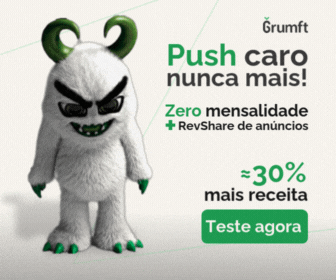Page RPM: 11 Ways to Increase This Metric on Your Website
Unlock Higher Earnings: Master the Art of Boosting Your Page RPM Today!

We know! RPM, CPM, and CTR can be a nightmare. But if knowing you’re not alone helps, we can state that many publishers are looking for alternatives to increase page RPM right now. However, effectively improving these metrics can be a challenge, especially if you don’t implement the right strategies.
If you’re a Grumft ad partner, welcome to our blog! But if you’re not yet, we hope this content motivates you to explore our exclusive programmatic solutions for publishers and advertisers. In this article, we’ll show you 11 ways to boost your site’s page RPM. Keep reading to learn which strategies to implement.
What is Page RPM?
First and foremost, it’s important for you to know that RPM stands for “Revenue Per Mille” (Mille, from Latin, thousand). In other words, page RPM is the estimated earnings when the page is viewed a thousand times by readers, with each reader having a value associated with this metric.
How is Page RPM Calculated?
To calculate page RPM, your estimated earnings are divided by the number of page views and then multiplied by 1000.
Example: If you earned an estimate of $15 with 500 page views, your page RPM would be equal to ($15 / 500) * 1000, which is $30.
You need to know that Google uses the term eCPM interchangeably with RPM, meaning RPM and eCPM are the same.
In the example, achieving a $30 RPM might seem easy, but we can assert that it’s not. You need to accomplish this without overwhelming readers with ads and harming their experience on your site. But the good news is, you can achieve it.
What Affects Page RPM?
The key metrics affecting page RPM are:
- CTR (Click-Through Rate): a metric used by advertisers to know how many clicks they can get from an ad per X impressions. If your site gets 5 clicks for every 100 impressions, your CTR is 5%. Therefore, the higher the CTR, the higher the page RPM.
- CPC (Cost Per Click): the value an advertiser is willing to pay for a click. It varies based on ad content, context, and niche.
To ensure the highest possible CTR and CPC, you know you need to publish quality content—content that attracts and retains readers interested in a specific niche—and find the right ad placements to use. This way, you ensure high viewability, consequently increasing CTR and CPC.
You also need to ensure that ads are highly relevant and resonate well with readers. In this case, having an excellent programmatic ad partner is crucial.
How to Increase Page RPM
In addition to CPC and CTR, you can also improve page RPM by using the right ad sizes and formats, optimizing the site for a better user experience, and implementing advanced ad refreshing methods, among other techniques. Keep reading to learn more about these strategies.
Use the Right Formats
In addition to display ads, you can use various ad formats, including video ads, stick ads, expandable ads, text ads, interstitial ads, and more. You need to experiment with formats to choose the right ones for your site. However, there’s no guarantee that you’ll earn more by replacing display ads with video ads. Only through testing will you find the ideal format combination and replace lower-performing formats.
Enable the Right Ad Sizes
Not all ad blocks yield good eCPM. You can follow Google’s recommendation and use wider ad blocks to increase CPMs and improve page RPM. Ad blocks like ‘300×250,’ ‘336 × 280,’ and ‘728 × 90’ have proven to yield better results due to higher demand.
Using ad blocks with more competition leads to improved page RPM. Furthermore, larger ad sizes tend to have higher CTRs and can further increase page RPM. It’s also important to consider ad viewability, as higher visibility leads to better rates.
Optimize User Experience
We’ve already identified that enhancing the user experience results in higher revenue. The goal should be to provide clean content and an acceptable number of ads. However, achieving this requires testing to find the right ad quantity.
A simple way to ensure a better user experience is by limiting the number of ads on the page and ensuring they’re distributed harmoniously. After all, when readers consume content fully, you can have “Below The Fold” (BTF) ad blocks instead of many “Above The Fold” (ATF) blocks.
Optimize Core Web Vitals
Optimizing Core Web Vitals improves visibility, reduces bounce rates, and increases page RPM. In addition to significantly improving all these metrics, Core Web Vitals are influencing SEO practices, traffic from discovery tools and Google News, and consequently, revenue.
Committing to user experience and page loading speed is the right path to enhance engagement and advertising revenue, along with other metrics valued by advertisers.
Attract the Right Visitors
Attracting relevant visitors is crucial. Focusing on the right audience instead of getting a ton of irrelevant visits will considerably improve your RPM.
As you know, RPM varies based on traffic quality. Therefore, repeated or recurring visitors may achieve a better RPM, as Google can better identify the user on their second visit to your site. Similarly, paid traffic tends to have higher bounce rates and less time on the site, resulting in a lower-than-expected page RPM.
Have a Google Ad Manager Account
If you have more than 200 thousand page views, you can sign up for Google Ad Manager (GAM). GAM is an ad server that allows you to set up campaigns with up to 15 Ad Networks. Furthermore, as a Grumft partner, you can use Gnet (our DSP software) to conduct direct sales campaigns to your advertisers with several advantages, such as:
Ease of executing direct campaigns compared to GAM. Navegg targeting. Dashboard for your advertiser to view, but not edit, campaign results.
This is because when you activate our tag on your site, the inventory data you’ve delegated to us is synchronized with Navegg, which delivers ads to the corresponding target audience with a high degree of accuracy by enabling ad buyers to access specific audiences.
Implement Header Bidding
Google Ad Manager helps improve ad fill rate, and Gnet facilitates direct campaign execution, but you can further increase your eCPM by implementing Header Bidding, which allows you to call multiple demand partners (ad exchanges / ad networks / SSPs) simultaneously, ensuring fierce competition and higher eCPM. However, to enhance your results with Header Bidding, you need to have at least one million page views per month.
Try Refreshing and Stick Ads for More Impressions
Fixed containers provide only two ads if you’re not refreshing them, but you can deliver dozens of impressions in the same locations if you start refreshing them. When your locations are fixed, they can’t be refreshed if they’re outside the viewport, and ads shouldn’t refresh when the user is on a different tab, as this practice is considered ad fraud.
Properly implementing ad refreshing increases impressions, maintains high visibility, and doesn’t require extra space. However, traditional refresh methods don’t consider whether a user is active on the page. This approach can lead to unsatisfactory ad performance.
At Grumft, we’ve developed a system that optimizes ads for better visibility and engagement, tracking user activity to ensure ads are refreshed only when the user is paying attention.
Increase Organic Traffic
Organic visitors tend to stay longer on the site and scroll to the bottom of the page if you offer the right content and an excellent experience. Furthermore, Google can more effectively direct ads to visitors who arrive via Google search. In turn, advertisers bidding through Google Ads also work with specific strategies to win that impression.
Therefore, analyze the interaction time of your referral sources and then select the top 3 traffic sources and focus on them. It’s important to highlight that paid traffic, such as that from networks like Taboola and Facebook, tends to have higher bounce rates, unless you establish proper targeting.
Enhance Content Recommendations
Many publishers overlook the impact of content recommendations on revenue. But you should know that showing users what other content you offer is important. By recommending content to users who arrive via Google search, for instance, you can suggest highly relevant content that motivates them to click and then view another relevant part of the content. After all, the more page views, the better the RPM.
Improve Content Quality
Consider your content as a product. Therefore, if your site’s content is better than that of other publishers competing in the same niche, you’re more likely to get a higher ranking on the Search Engine Results Page (SERP). This means more traffic, higher page retention, and ultimately, a higher page RPM. Use multimedia content with images, audio, slides, videos, etc., to enhance interaction. Furthermore, develop a design system for your site and create a brand around your content.
Guaranteed CPM and Grumft’s Stick Ads: HTML Innovation
Integrating guaranteed CPM with Grumft’s stick ads through the insertion of HTML tags on the site is an effective strategy to boost page RPM and revolutionize monetization for publishers. Implementing stick ads via HTML tags positions the ads in a fixed manner, either at the top or bottom of the screen, ensuring constant visibility without compromising the user experience. This approach not only significantly improves viewability and interaction rates but also enables publishers to achieve a guaranteed CPM, contributing to a substantial increase in page RPM.
Adding the stick ad tag in HTML simplifies the execution of this advertising tactic, optimizing both ad performance and the overall site experience without negatively impacting loading speed. With Grumft’s solution, publishers can rely on a more stable and predictable revenue source while enhancing user engagement. This combination of guaranteed CPM and stick ad optimization highlights Grumft’s ability to harmonize the increase in page RPM with user satisfaction, setting new standards of effectiveness in the digital advertising environment.
Final Thoughts
In summary, these 11 techniques will greatly help you improve page RPM on your site. It may take time to see results, but the best way to apply these insights to your site is to start evaluating the most suitable strategies right now.
Begin with user experience and page loading time, and then fine-tune the other strategies. Above all, count on Grumft to support you on this journey.
Leia também:

LTV vs CAC: A Matemática da Sobrevivência Digital

Ad Mediation is Broken. The Unified Auction is How You Fix Your Revenue.

Análise do Ciclo de Vida do Assinante: Guia de Engajamento e Receita para Publishers
Autor(a):
Fernanda Calandro
Online desde 1997, sou uma profissional de marketing e conteúdo com formação robusta em marketing. Especializada em simplificar temas complexos através das minhas redações, eu facilito a conexão entre publishers e especialistas, promovendo um entendimento claro e acessível.
